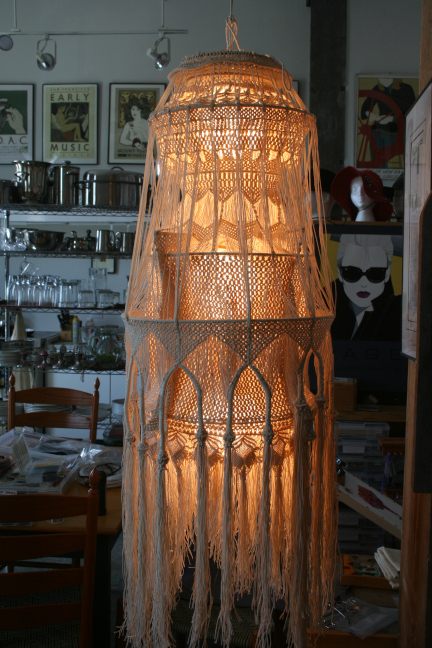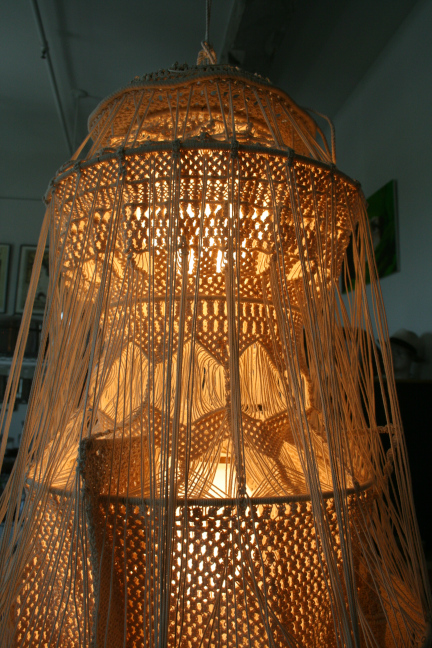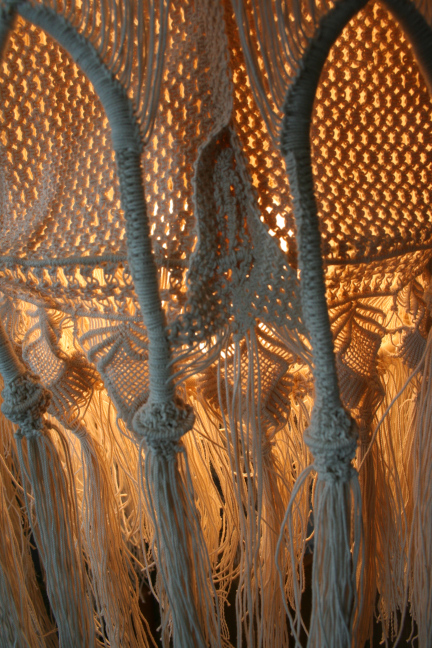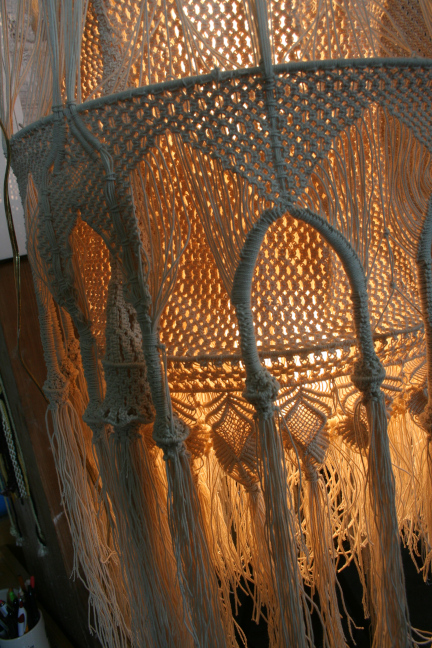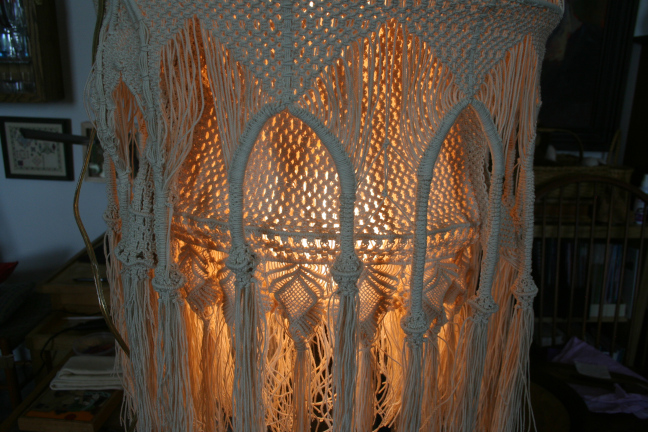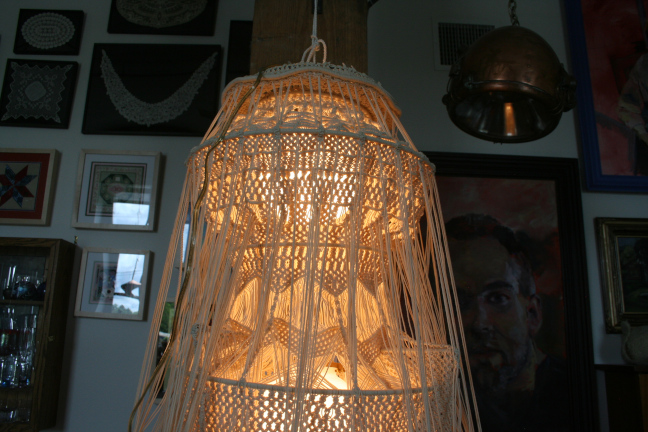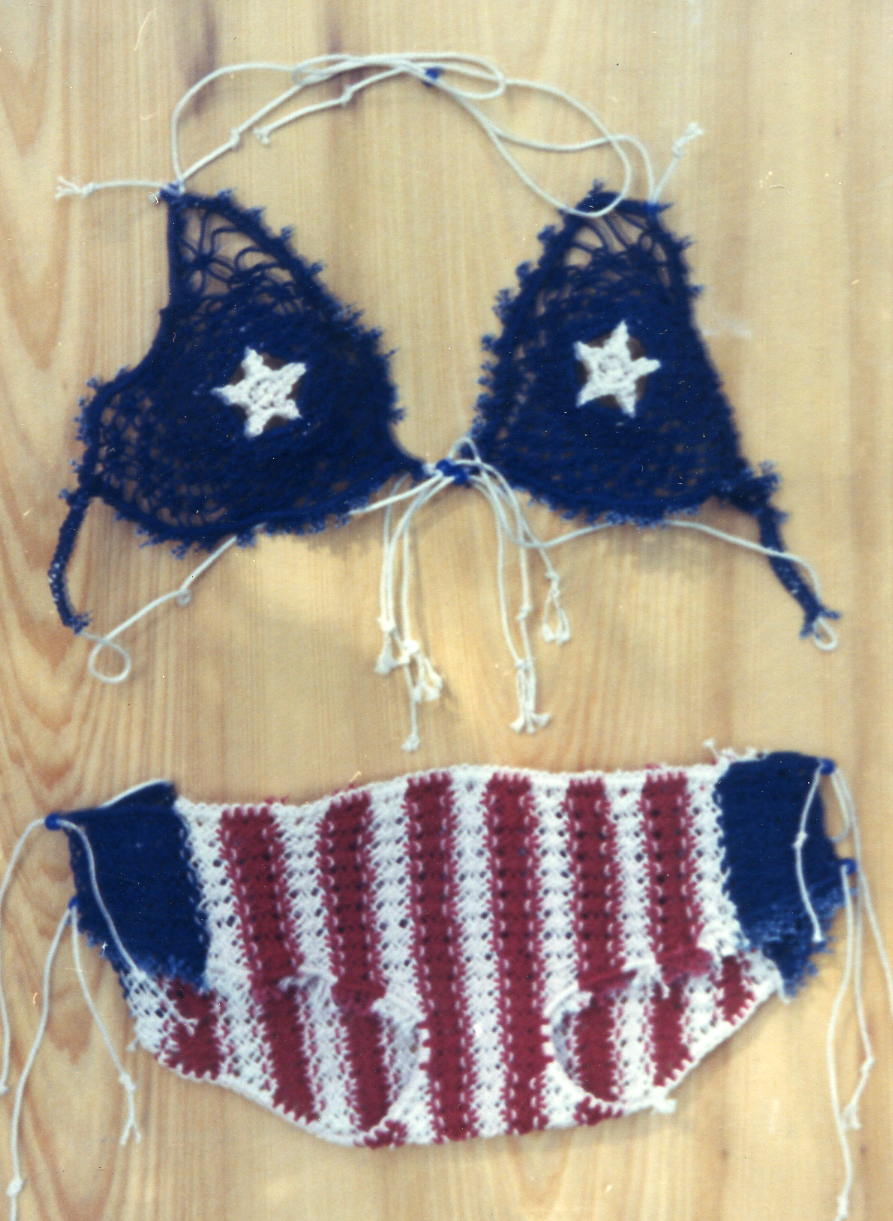

Sometime in 1968 a dear friend invited us to come over to her house to watch "The Forsyte Saga" on PBS. We did not have a television at the time and thought it would be fun to watch this semi-historical drama about Edwardian England with a friend. Our host worked on her needle work while watching and Ellen knit. I needed something to do and started doing Macrame, decorative knotting. At the time, Macrame was becoming popular and we got our start reading a book on the topic by Virgina Harvey.
Before long, Ellen was knotting, too. And in a matter of months, we had progressed to projects beyond those in the available book sources of the day. In particular, probably because we both knit, we got interested in the three dimensional shaping possibilities of the craft. After purses and belts, we went on to do lampshades and clothing and eventually very elaborate sculptural pieces.
We also researched the history of fancy knotted ropework and found the nautical connection. Our interest in traditional sailor's ropework led to meeting Norman Rack through a mutual friend. Norman was a hard hat diver who worked largely on the oil platforms in the Gulf, but was laid off at the time we met him. He had a wealth of information and examples of nautical fancy ropework, and we ended up collaborating on a book in 1970.
As we got more interested in the sculptural possibilities of Macrame, the popular interest in the craft went another way, into plant hangers and wall hangings, often emphasizing the qualities of the yarns being used rather than the knotting. By the time we began to encounter "dead heads" making and selling macrame bracelets made from hemp twine, we realized we were out of step with popular culture. Around this time we relocated to New Hampshire and after a year or so of some gallery shows and making the rounds of craft fairs, we pretty much stopped doing decorative knotting. There were a few times when Gene returned to doing macrame, and those (probably) final projects are shown below.
Working with the proprietor of "The Sun Shop", we found an almost endless supply of the high quality cotton cord we used for our knotting. The cord was "seine twine", a hard twisted three ply rope-laid twine formerly used mostly for fishing nets. It came in an assortment of weights and sizes and is discussed further in the Rope Making section of the General Information page in the Ship Modeling area. The twine we used was spun from Sea Island Cotton, a long staple cotton grown on the coastal islands off Georgia. It had a polished - looking finish, a smooth texture, a slightly beige color, and the twine held knots better than any other cord we ever found. The cotton industry had changed in the mid 20th century with the decimation of the Sea Island cotton plants by boll weevils together with social and economic changes in the Sea Islands. The cotton was hybridized with Egyptian cotton to create Pima cotton, recognized as the finest long staple cotton today, but inferior to Sea Island Cotton. Cotton seine twine made from Sea Island Cotton is no longer available and the seine twine available today is softer and less durable and does not knot as well. In 2022 used the last of our supply of Sea Island Cotton on the large Macrame Lamp shown at the end of this page.
We also made and sold macrame items at The Sun Shop - belts, purses, and even bikinis.
Here's one of our bikinis modeled by Geraldine Duskin, who was the model for all the pictures in our first book.

And through that, we met Jim and Jac Ward, who encouraged us to write our first macrame book, "Practical Macrame" and taught us how to prepare and submit a book proposal to publishers. More about that in the page on Publications.
Here's that first Macrame book. And the second. For both books, Ellen was as active as I was in doing the work. Tha's one of her decorative lamps on the cover of the second book.
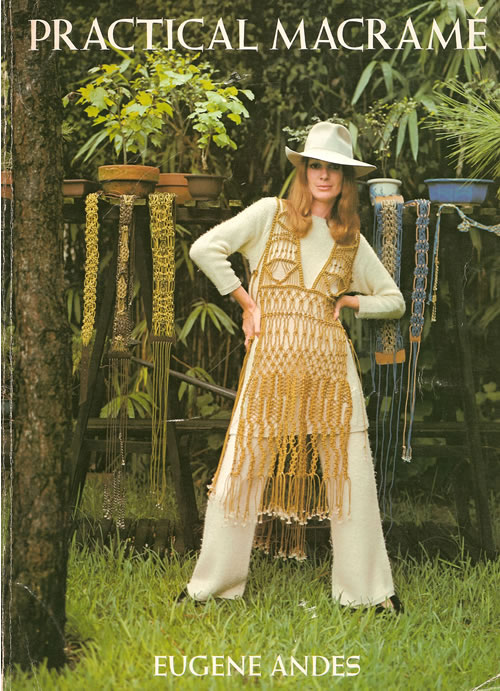

As part of making items for sale, we experimented with nylon seine twine. This twine was essentially the material that had replaced cotton twine for use in fishing nets. It was not only stronger, it did not rot and the nets therefore did not have to be so carefully dried after use as did the cotton nets. But the nyon had some other differences that made it less satisfactory for knotting. It needed to be heat fused on the ends to prevent unraveling, for example, and it was more slippery than the cotton twine, so the items made from it were of slightly different design. But it too dye well and we soon were making belts and vests that were quite colorful. The Sun Shop owner made a very successful selling trip to New York City with our nylon belts, which hit the market around the time the "midi dress" did. These dresses were generally somewhat plain, in muted colors, perhaps a reaction to the "mini dress" of the early 1960s, and retailers in New York realized quickly that buyers of midi dresses would want something bright and flashy as accessory to the dress. Our belts were just the thing, and we sold a lot of them in a very short time. The demand fortunately lasted as briefly as the popularity of the midi dress, which was a good thing for us, as we had already decided to move from producing quantities of macrame products to writing books and teaching others how to make their own macrame things.
Here are a couple of the belts we made out of nylon seine twine. We dyed the twine with RIT dye, boiling the twine in the dye on our kitchen stove.


For the first book, we participated in a "book tour", having interviews with local lifestyle columnists in Boston and New York, appearing on a local television show in New York - where they even hired a model to wear the Red White and Blue bikini at the top of this page - and going to craft shows and even a teachers' convention in New York to teach macrame to public school art teachers.
But we were continuing to evolve into more sculptural work by 1971. One project was a swing, made from an old wagon wheel iron tire we found at the farm. Here's a photo of the completed swing hanging from a tree at the farm. Later, I made a second swing. There's a shot of the second one in progress, and finally a picture of the kids in the second swing, when I got it out of storage in the barn for them to use. It lasted a season or two in the savage New Hampshire weather.
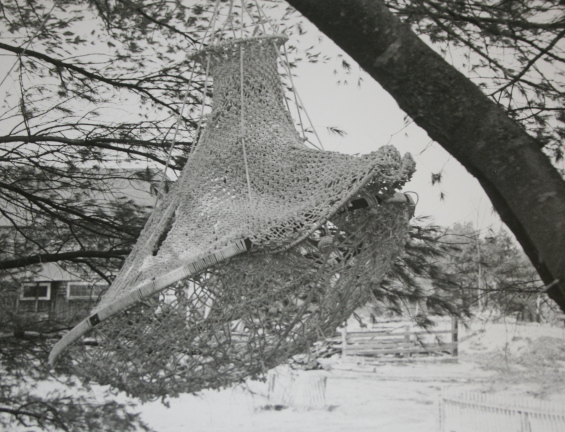


Here's a picture of Blackie's lamp.

I also did a macrame castle, which was to be a playhouse for children. I donated this piece to the local PBS station for their fund raising auction, and it was purchased by a friend and spent some time in their family room. That was the last big sculptural piece.

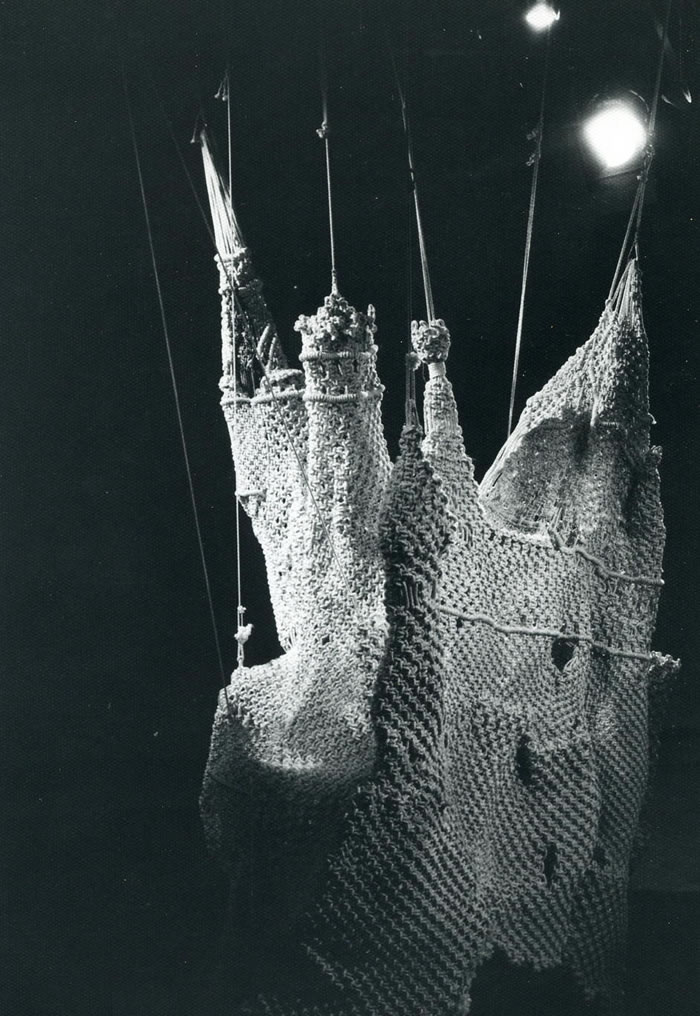
As mentioned above, I occasionally returned to knotting in the ensuing decades. The projects varied. I made another macrame bikini for a friend.
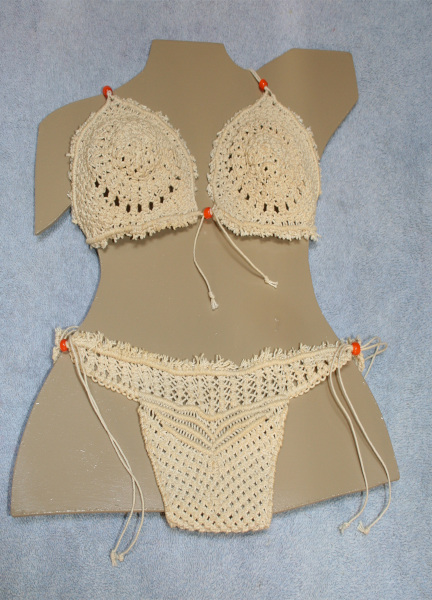
I did some nautical knotting as decoration on some bottle ships made during the COVID pandemic in 2021. It was a chance to go back and re-learn how to tie large Turk's Head knots. I had forgotten how to do this and ended up pulling out my Macrame books to use the instructions there. And they were pretty good instructions, I must say.
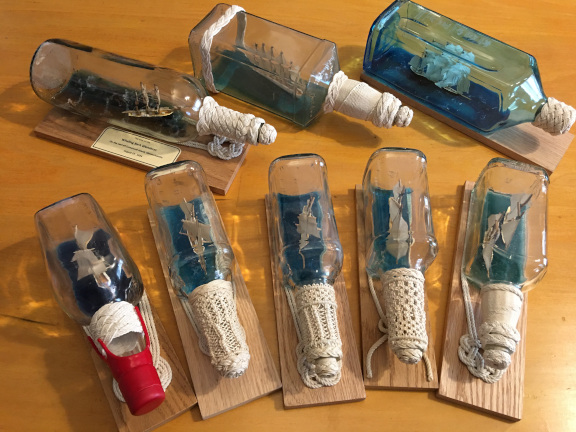
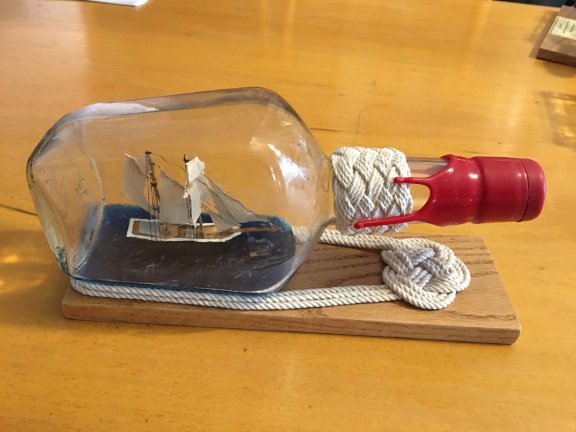
I did the last bikini when we lived in Santa Fe. When I got the box containing the last of the Sea Island Cotton twine out to make the bikini, I promised myself I would use up the rest of that fine cord. There were perhaps 4 pounds of the number 12 twine and a little bit of the 90. I started a hanging lamp with the intention to use up the rest of the twine on that single project. When we moved back to New Orleans, the project went back into the box for another seven years, but I got it out and finished it when we moved into a loft style apartment with tall ceilings in 2022. The finished piece is four feet tall and eighteen inches in diameter. It has three six inch globes with 15 watt LED bulbs. The piece is knotted using only square knots (left and right-handed), clove hitches, and Lark's Head knots.
Only a few scraps of the number 12 twine remain. There is perhaps enough left to do a small simple lamp. Or perhaps not.
I did purchase some cotton seine twine to use for the knotwork on the bottle ships. The modern stuff is suitable for knotting but is markedly inferior to the Sea Island twine. My knotting days are likely over, other tha perhaps some decorative work on future ship model cases.
Here are pictures of the "final" lamp.

